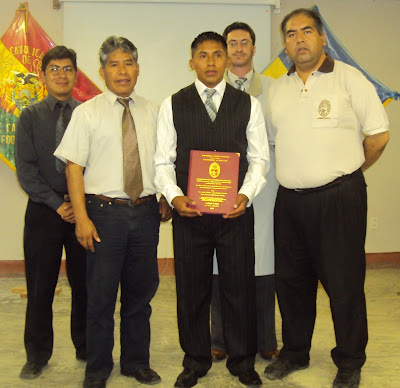“Ecology is the interdisciplinary scientific study of organisms and their interactions with the environment. In ecology we use the ecosystem as a unit of study, and in class we find ourselves in the field measuring populations, writing in our journals, thoughtfully stepping from one ecosystem to the next. It is becoming apparent that a rapid response to the global crisis confronting an ever-shrinking biological diversity will be necessary.
“Ecology has become a hot topic here because Bolivia is among the most biodiverse countries in the world. Recently it was announced that the country will host a meeting initiated by President Evo Morales called the First World Conference of People on Climate Change and the Rights of Mother Earth. The results of this conference are yet unknown, but it demonstrates a move in the Morales government towards recognition of critical issues in conservation and environmental health.
“I believe that students with a good background in ecology will help to guide society toward the conservation natural systems, and toward sustainable management of environmental resources. It is also important to integrate ecological knowledge into agriculture and ecosystem restoration. Students often describe ecosystems and biodiversity in Bolivia in terms of pisos ecológicos (ecological zones). Bolivia is known for 5 distinct pisos ecológicos: Puna, Altiplano, Valles, Yungas and the Lowlands. When one travels to Carmen Pampa from La Paz one passes through all of Bolivia’s distinct pisos, with the exception of the Lowlands, in less than 100 km!

Kyle in the classroom.
“Many different civilizations have worked in these ecological zones to develop a great diversity of food. The Yungas is an incredibly diverse and important zone itself. The Yungas forests that surround us are extremely diverse, ranging from moist lowland forest to evergreen montane forest and cloud forests. The steep valley walls are where people carve out their agricultural lands. This extremely rugged and varied environment contributes to the ecological diversity and richness. There are high levels of biodiversity and unique species throughout the Yungas regions. Unfortunately forest in this area is being lost due to the intensification of agriculture and increasing demands from the world’s cities.
“The students here at the College are introduced to concepts that are becoming increasingly important, and many of them have first-hand experience. They have experienced the many uses of native forest, the effects of contamination and conservation, and the consequences of population growth. These topics are especially relevant in the agronomy department: the futures of agriculture and food security are directly related to these issues.
“Saint Francis was an early ecologist and naturalist, observing animals, writing about them with affection, and recognizing their importance. Student come to class with a combination of direct experience in the field and a respect cultivated through the teachings of Saint Francis. They understand the natural environment, they know plant and animal names, and they have seen population dynamics in action in agricultural pests and diseases.
“By applying concepts of ecology to agriculture, we can produce food that is healthier, and conserve the natural environment for the important services it provides, services that help maintain life on this planet. It is my hope that these students will begin to learn how to make agrarian environments more livable, integrating ecology with food production; and the youth of Bolivia will start to return to rural areas for a better quality of life while contributing to food production. My students are asked to do a research project on a topic of ecology that interests them, and students have chosen topics as diverse as contamination of water, deforestation, and the introduction of exotic species. Students have demonstrated a high level of commitment to working towards resolving environmental issues that rural areas are facing.

Ecology student José Luis Chipana counts beans in a biodiversity exercise.
“Farmers are often the people most aware of the environmental changes. They are also aware of a need for a combination of environmentally sound food production and conservation. At Carmen Pampa, by empowering young farmers as future community leaders, I am hopeful that these leaders will bring thoughtful consideration and positive change to their communities.”
We are grateful for Kyle’s presence here, for his contributions to the College, his research that will lead to a greater understanding of how food is produced and used, and the spirit of unity and knowledge that he brings.











